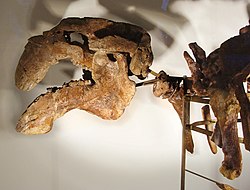Eotheroides
|
Eotheroides Temporal range: Middle - Late Eocene, 48.6–33.9 Ma |
|
|---|---|
 |
|
| Eotheroides sp. in Artis, Amsterdam. | |
| Scientific classification | |
| Kingdom: | Animalia |
| Phylum: | Chordata |
| Class: | Mammalia |
| Order: | Sirenia |
| Family: | Dugongidae |
| Genus: |
Eotheroides Trouessart, 1905 |
| Species | |
Eotheroides is an extinct genus of Eocene sirenian. It is an early member of the family Dugongidae, which includes the extant dugong. Fossils have been found from Egypt, India, and Madagascar. Eotheroides was first described by Richard Owen in 1875 under the name Eotherium, which was replaced by the current name in 1899.
Based on endocranial casts, Eotheroiodes had a smaller endocranial volume than other contemporaneous sirenians such as Protosiren. Unlike extant sirenians, Eotheroides possesses a tentorium cerebelli, which appears as a distinct transverse groove on the skull.
The type species, E. aegyptiacum, is known from the Lutetian Mokattam Limestone of Cairo, Egypt. Another species, E. lambondrano, was recently named on the basis of material found from Middle Eocene nearshore marine deposits in the Mahajanga Basin of Madagascar. The species was named after the Malagasy word for dugong, which translates as "water bushpig". It is known from a nearly complete skull and fragments of pachyosteosclerotic (thick) ribs. Based on its age and morphology, E. lambondrano may be ancestral to E. aegyptiacum. Described in 2009, E. lambondrano is the first pre- Cenozoic mammal named from Madagascar, being known from an 80-million-year gap in the island's fossil record.
Several other species have been named, including E. babiae from India,E. majus, E. clavigerum and E. sandersi from Egypt, and E. waghapadarensis, also from India.E. majus was based on a single upper molar, which was never catalogued and is now lost; it has been considered a senior subjective synonym of E. aegyptiacum.
...
Wikipedia
